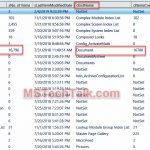Taking backup is one of the top priority of DBA’s as users don’t want their data to get lost. As if any any mishappening occur due to any of the reason like hardware failure, faulty drivers they plan backup & restore strategy to protect their data from getting lost.
This blog will help you in making strategy on How to backup & Restore SQL Server database 2017, 2016 & all its below version.
This topic has several answers and here we will review the best option. But before that, first let us find out some points to understand Why backups are important?
Why Backup is important ?
Disaster is anything which are not planned and can occur at any time. Hardware failure, Media failure, Faulty disk drivers, dropping any of the database object mistakenly etc are some of the sudden disaster which can result in many failure.
Backups works as the saviour to protect your data from all type of disasters!
Storing copies of healthy backup in a safe location, running restores procedure on backups can help you to prevent the data from loss.
Not only this, Backups can also be useful for other processes also. They are useful for Administrative purposes such as Archiving, Database mirroring, copying db from one server to another etc.
Don’t know how to take backup in SQL Server Database? Let us know the process:
How to Take Backup in SQL Server?
You have various options to take backup of SQL Server database. You can do it by SQL Server Management Studio, by sqlcmd (if SSMS is not installed) or by running T-SQL script.
Let us know the easiest method to take backup!
Using SSMS :
- Open SQLServer Management Studio and Connect to the Server name or the instance of the server you want to backed up.
- Click on the Databases and Expand the database you want to backed up.
- Right click in the database you want to take backup of, Click on Tasks and then hit Backup.
- Set the type of the Backup as Full.
- Click on Add to add the location of the backup path. And Click Ok.
Using T-SQL
You can create backup of SQL Database by executing BACKUP DATABASE command. The syntax used to take full database backup is below:
BACKUP DATABASE database
TO backup_device [ ,...n ]
[ WITH with_options [ ,...o ] ] ;For example:
USE TestDb;
GO
BACKUP DATABASE TestDb TO DISK = 'Z:\SQLServerBackups\TestDb.Bak'
WITH FORMAT,
MEDIANAME = 'Z_SQLServerBackups',
NAME = 'Full Backup of TestDb';
GO You successfully have taken backup of SQL Server Database, now let us learn how to restore database backup in SQL Server step by step
How to Restore Database from Backup in SQL Server
Likewise, you can restore SQL database from backup in various ways using command line, SSMS or as T-SQL.
Using SSMS:
- Open SSMS and connect to the instance of SQL Database engine. Select the database you want to restore and expand the instance.
- Right click on the name of the database you want to restore, select Restore Database.
- In Source for restore option, select ‘From Device’ option.
- You will get the Destination section, you have an option to select the database. If you choose existing database, it will get replaced by the data from the backup Or if you choose the new name, it will get created.
- Select Option pane, Click ‘Overwrite the existing database’ (WITH Replace)
- Uncheck Take tail-log backup before Restore
- Click Ok
You can restore SQL Server database by T-SQL commands also:
For this,you just need to run the command according to the backup type. The below command restores a full database backup in SQL Server.
RESTORE DATABASE TestDb FROM DISK = 'C:\TestDb.BAK'
GOIf you are restoring differential database backup then Run,
RESTORE DATABASE TestDb FROM DISK = 'C:\TestDb.BAK' WITH NORECOVERY
GO
RESTORE DATABASE TestDb FROM DISK = 'C:\TestDb.DIF'
GOOr if you are restoring Transaction log Backup then run following commands:
RESTORE DATABASE TestDb
FROM TestDb_1
WITH NORECOVERY;
GO
RESTORE LOG TestDb
FROM TestDb_log
WITH FILE = 1,
WITH NORECOVERY;
GO
RESTORE DATABASE TestDb
WITH RECOVERY;
GO By running this command you can successfully restore SQL Server database.
Till now, we have learned various options how can we restore SQL Server database using SSMS and by T-SQL and importance of taking backup.
But What if your .bak file get corrupted? It could be the possibility that while restoring SQL Server database you might get SQL ERROR 3041. The error indicates the SQL Backup file corruption.
SQL Backup corruption can occur due to any sudden disaster occur in your system.What to do in that case?
What if your SQL .bak file get corrupted?
It could be the possibility that your .bak file is corrupted due to any of the reasons. Sometimes, if you try to restore the database you get SQL error code 3041, it means you are facing Backup File Corruption and it need to get repaired quickly.
Go for instant solution to recover backup file in SQL Server database. Download expert choice ie SQL Backup Recovery Tool. The tool repair .bak file and able to preview all database objects. It also recover MDF as well as NDF files which are saved within SQL backup file. As there is no file size limitation to repair SQL .bak file, it supports to recover SQL Server file of 2014, 2012 & all below its version.
Conclusion
Backups are important!! Backup in healthy state help us in disastrous situation. Learn the importance of backup and how to take backup in SQL Server database. Check out various methods to restore database according to database type. It also covers the solution if, somehow, your .bak file is found to be corrupted.









No Comments